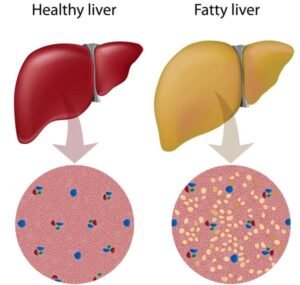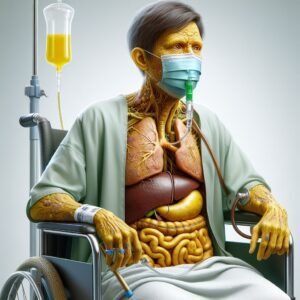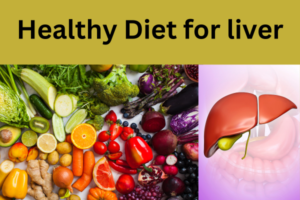Could Fatty Liver Disease Be Visible in Your Face? Five Signs You Must Be Aware Of
Overview
Your face may provide information about your general health, including the condition of your liver. A rising global health concern, fatty liver disease is frequently silent in its early stages. Nonetheless, some facial expressions could point to underlying liver problems. Early detection of these signs can result in improved results and prompt intervention.
Fatty liver disease: what is it?

When too much fat accumulates in the liver cells, fatty liver disease develops. It falls into two primary categories:
AFLD, or non-alcoholic fatty liver disease, is prevalent in people who are obese, diabetic, or have high cholesterol.
Excessive alcohol use is the cause of alcoholic fatty liver disease.
In its early stages, this illness is frequently asymptomatic, but if left untreated, it can cause significant liver damage.
The Significance of Facial Symptoms
Your internal well-being may be reflected in your face. Liver dysfunction may be indicated by changes in the color, texture, or appearance of specific skin features. Let’s examine the top five symptoms that could point to fatty liver disease.
1. Jaundice, or yellowish skin or eyes

Jaundice is one of the most obvious symptoms of liver disease. This happens when liver dysfunction causes bilirubin, a consequence of red blood cell breakdown, to accumulate in the blood.
Causes: The liver’s capacity to handle bilirubin may be slowed by fatty liver disease.
Yellowish yellowing of the skin and eye whites is one of the facial clues.
What to Do: Get medical help right away if you observe persistent discoloration.
2. Under-eye dark circles
Visible dark circles may be caused by chronic fatigue and liver dysfunction. Although sleep deprivation is sometimes blamed for dark circles, they could be an indication of something more serious.
Underlying Problem: Fatigue and changes in skin appearance are caused by a slow liver’s inability to cleanse the blood.
The way it appears: deep, ongoing darkening under the eyes that doesn’t go away when you sleep.
Advice: Make sure your food is balanced, and if the problem continues, see a doctor.
3. A puffy or swollen face
A bloated face may indicate fluid retention, which is frequently linked to liver issues.
Reason: Fluid balance is regulated by the liver. Swelling may result from fluid buildup in tissues when it is compromised.
Signs include puffy cheeks, swollen eyelids, or a generally bloated look.
Solution: Keeping hydrated and cutting back on sodium may help, but a doctor’s assessment is required.
4. Face Redness or Spider Veins
Telangiectasia, often known as spider veins, are tiny, noticeable blood vessels that can develop on the face. These are frequently connected to liver disease.
Why It Occurs: Blood flow and hormone regulation are impacted by impaired liver function.
It appears around the nose or cheeks.
Action Plan: Although a dermatologist can treat superficial symptoms, a liver health evaluation is essential.
5. Dry or itchy skin that cannot be explained
Dryness and itching of the skin might be caused by chronic liver problems. This is frequently brought on by a buildup of toxins or decreased bile production.
Symptoms that are visible include flaky areas or continuous facial irritation.
Other Indications: Dryness may be accompanied by darkened skin or tiny pimples.
Prevention: The long-term approach is to address liver health, while moisturizers can offer short-term respite.
Fatty Liver Disease: What Causes It?
Fatty liver disease has multiple contributing causes. Among the main factors are:
Poor diet, particularly one that is heavy in sugar and processed foods.
Metabolic syndrome and obesity.
drinking alcohol.
genetics or underlying medical disorders, such as diabetes.
Strategies for Avoiding Fatty Liver Disease
It’s always better to prevent than to treat. Here’s how to maintain the health of your liver:
A balanced diet and regular exercise are essential for maintaining a healthy weight.

Limit Alcohol Consumption: Drinking too much alcohol might cause liver damage.
Maintain Hydration: Detoxification is aided by adequate hydration.
Frequent Checkups: Liver enzyme levels can be detected early with blood tests.
When to Consult a Physician
See a doctor if you observe any of these facial signs or if you suffer from unexplained exhaustion, stomach pain, or swelling. The development of more serious diseases like cirrhosis or liver cancer can be stopped with early identification.
In conclusion
You might be surprised to learn how much your face can tell about your health. By monitoring for changes such as spider veins, puffiness, or jaundice, you can identify early warning symptoms of fatty liver disease. Make liver health a top priority by leading a healthy lifestyle, getting regular checkups, and getting help right away if symptoms appear.
1. Is it possible to reverse fatty liver disease?
Indeed, dietary and activity modifications can often reverse the early stages of fatty liver disease.
2. Does liver illness always manifest as facial symptoms?
Not all the time. Although there are numerous reasons for facial changes, a doctor should be seen if symptoms are persistent or inexplicable.
3. Does fatty liver disease run in families?
Although lifestyle factors like nutrition and exercise have a big influence, genetics might also play a part.
4. Is fatty liver disease possible in children?
Yes, particularly if they have metabolic syndrome or are fat.
5. Which tests are used to identify fatty liver disease?
Fatty liver disease is frequently diagnosed by ultrasound, CT scans, or blood testing (liver enzymes).


2 thoughts on “Could Fatty Liver Disease Be Visible in Your Face? Five Signs You Must Be Aware Of”